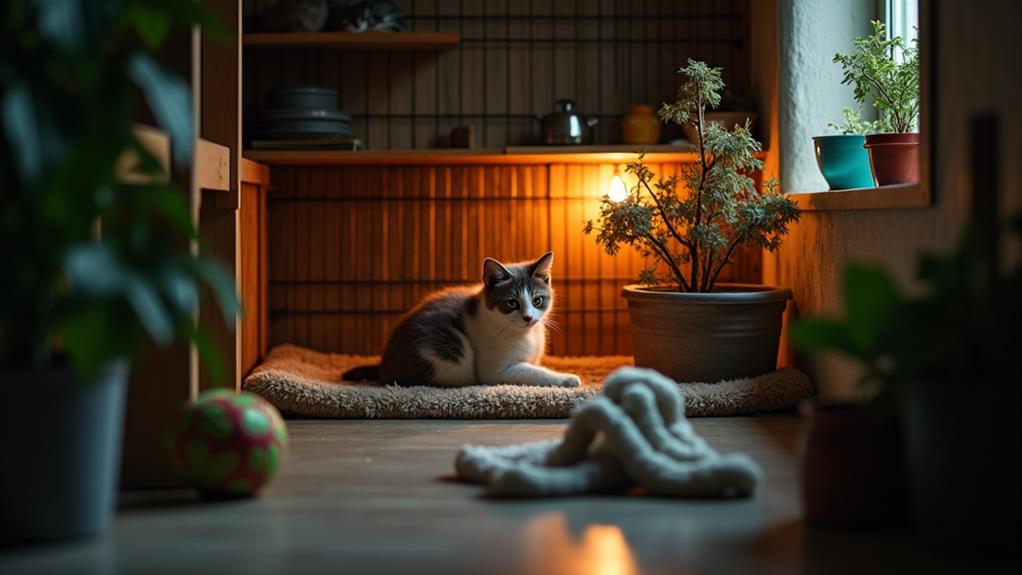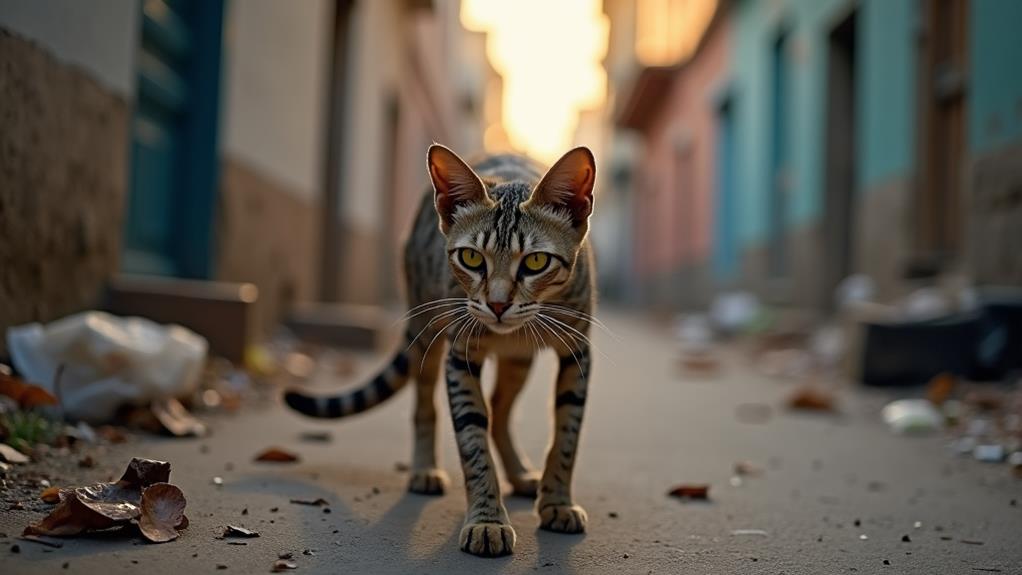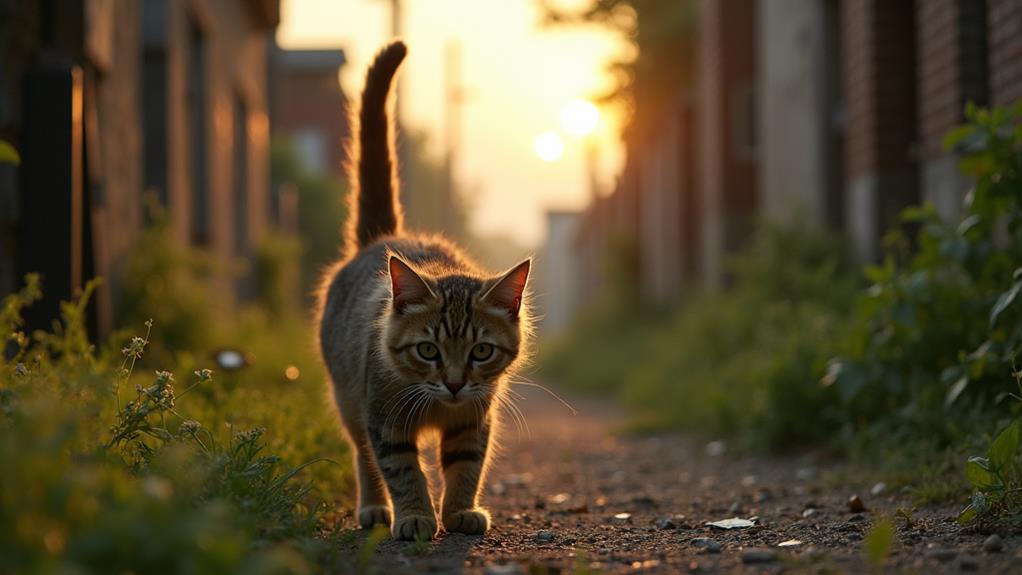How to Transition a Feral Cat to Indoors: A Complete Guide
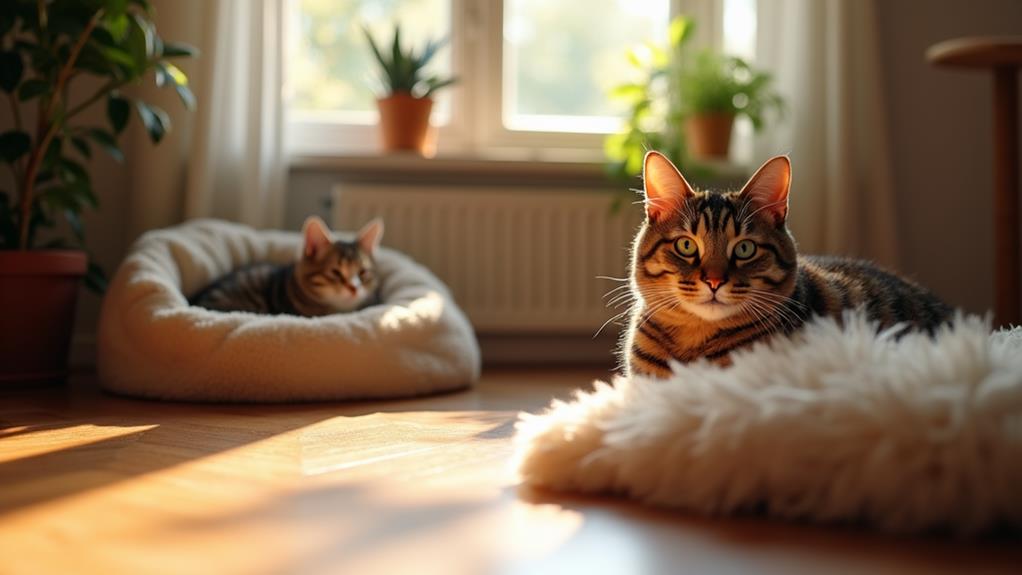
Bringing a feral cat indoors involves patience and understanding. Begin by evaluating the cat's temperament, as younger or previously domesticated cats adjust more easily. Prepare a secure, quiet room with litter boxes, cozy bedding, and food and water bowls. Introduce the cat slowly, using treats to build trust, and observe its body language to guide interactions. Implement litter box training with clean garden soil and make sure the environment is enriched with toys and scratching posts. Gradually expose the cat to your home, keeping an eye out for common challenges like hiding. Investigate further to guarantee a smooth adjustment.
Assessing the Feral Cat's Temperament
Understanding a feral cat's temperament is often vital when shifting it to indoor living. Feral cats each have unique temperaments that greatly influence how easily they adapt to indoor environments. If a cat was previously domesticated, you might find it adjusts more readily to living indoors compared to those with no human interaction history. Maturity is significant too; younger kittens typically adapt faster, while older feral cats, holding onto survival instincts, might be more challenging.
To build trust during this change, observe the feral cat's body language. Signs of comfort or distress can tell you how ready they are for interaction. If a cat has been fed or cared for by people before, it might show varying degrees of acceptance, a positive factor when you're gaining its trust. Paying close attention to these cues allows you to tailor your approach, ensuring a smoother adjustment.
Conducting a temperament assessment can help you decide which strategies to employ. Some feral cats may need extra time and patience. Understanding their behavior and comfort levels is key to making their change to indoor living successful and less stressful for both you and the cat.
Preparing the Indoor Environment
Creating a welcoming indoor environment is crucial when moving a feral cat to indoor living. Start by setting up a secure space, such as a quiet room away from high-traffic areas. This gives the cat a calm place to adjust without overwhelming stimuli. Ascertain this space includes the necessities: multiple uncovered litter boxes for easy access, cozy bedding for comfort, and food and water bowls to meet basic needs. Toys will also keep your new indoor cat engaged and entertained.
Incorporate vertical elements like cat trees and shelves. These mimic outdoor climbing opportunities, giving the cat a chance to investigate and observe from a safe height. This setup helps the cat feel more at ease in its new surroundings. Position scratching posts in different locations around your home. These cater to the cat's natural scratching instincts, helping with territory marking and claw maintenance.
Gradually add stimulating elements like bird feeders outside windows. This provides visual entertainment, keeping your cat mentally enriched as it becomes accustomed to indoor life. Preparing the indoor environment thoughtfully can make the change smoother, helping your feral friend feel more at home inside.
Initial Steps for Integration
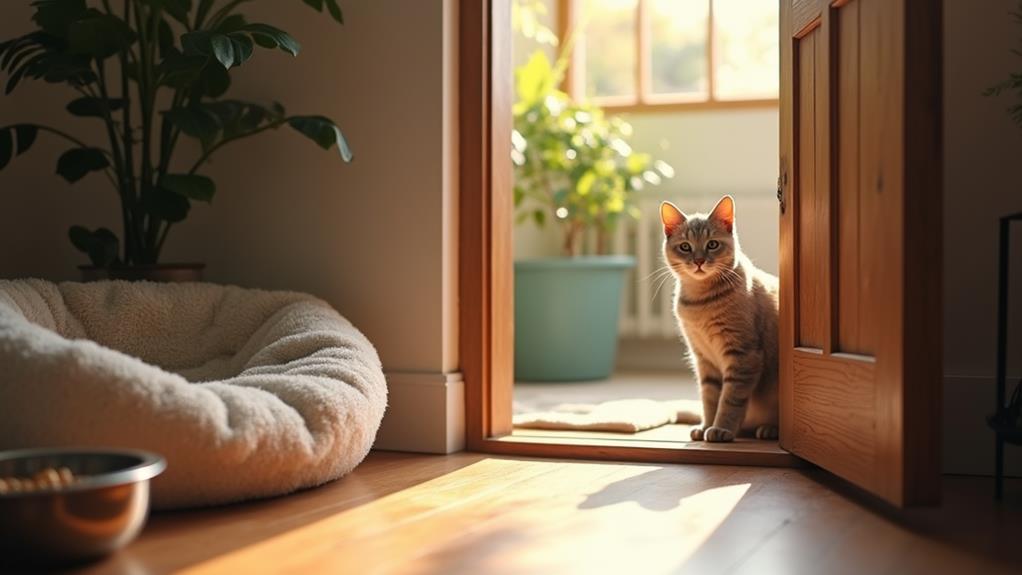
When shifting a feral cat indoors, start with a thorough veterinary check-up to guarantee its health and address any immediate medical needs. This step is essential as it allows you to spay or neuter the cat, which helps in calming its behavior during the change. Once your cat is healthy, prepare a safe, quiet room, like a small bathroom, to serve as a secure initial space. This space should be free from overwhelming stimuli, giving your cat a chance to adjust slowly.
To help your feral cat feel more comfortable, consider adding a covered kitty condo or a corner cubby. These provide a secure retreat where the cat can hide and feel safe while getting used to its new indoor environment. Gradually introduce your cat to the rest of the home by initially limiting its exposure to new sights, sounds, and smells. This gradual approach helps reduce stress, allowing the cat to adapt at its own pace.
Building trust is key. Establish a consistent feeding routine and allow the cat to approach you on its terms. This fosters a positive association with its new home, making the adjustment smoother.
Litter Box Training Essentials
Litter box training is an important step in shifting your feral cat to indoor life. Feral cats are accustomed to natural settings, so using clean garden soil in the litter box initially can make the change smoother. This familiar substrate encourages them to use the litter box, easing their move to an indoor-only lifestyle. Place at least two uncovered litter boxes in different locations to offer options and reduce the chance of accidents. Position them strategically in areas where your cat won't feel trapped, ensuring easy escape routes to enhance their comfort.
Cleanliness is significant as feral cats are highly sensitive to it. Make sure to clean the litter boxes daily to maintain hygiene and encourage regular use. Monitor your cat's usage closely; be ready to adjust litter types or box placements if your cat shows signs of discomfort or avoidance. This observation helps you understand their preferences, which is critical for a successful shift to indoor living. Patience and adaptability are key. With the right setup, you'll create a comfortable and inviting environment that respects your feral cat's instincts while promoting their new indoor lifestyle.
Building Trust With Your Cat
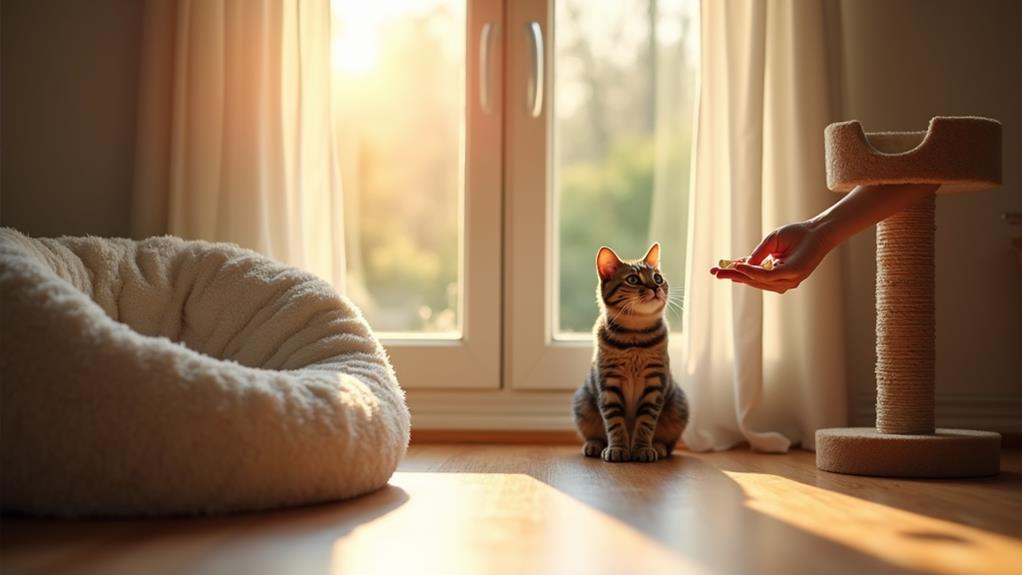
As you work on litter box training, focusing on building trust with your feral cat is just as vital for a smooth adjustment to indoor life. Trust is the foundation of a harmonious relationship, and creating positive associations is key. Regular meals can be your primary tool in this process. By offering food consistently, you're teaching your cat to associate your presence with something positive.
Here are three steps to help foster this trusting relationship:
- Approach Slowly: Always approach your feral cat gradually. Avoid cornering it, as this can create fear rather than trust. By moving slowly, you help establish a sense of safety.
- Encourage Interaction with Treats: Spend quiet time in the same room, tossing treats gently. This encourages interaction on the cat's terms and promotes a relaxed environment.
- Transition to Hand Feeding: Start by feeding with a long-handled spoon and gradually move to hand feeding. This step-by-step approach allows the cat to become more comfortable with closeness.
Pay attention to the cat's body language, letting it dictate the pace of interaction. This patience and respect will ultimately lead to a trusting relationship with your feral cat.
Providing Enrichment Activities
To guarantee a smooth shift for a feral cat into indoor life, providing enrichment activities is essential. These activities help stimulate cognitive skills and prevent boredom, making indoor cats feel more fulfilled and less stressed. One effective method is using puzzle feeders, which not only mimic hunting behaviors but also mentally engage your cat, offering both physical activity and mental stimulation. By incorporating these tools, you can improve your cat's indoor experience.
Introducing scratching posts can also benefit your feral cat. They allow for natural claw maintenance and territory marking, reducing anxiety by providing an outlet for instinctual behaviors. Scratching posts are necessary for creating a stress-free environment where your cat can thrive.
Toy balls filled with treats are another excellent way to engage your cat in playful challenges. These toys promote physical activity and keep your cat's mind sharp. Moreover, offering a variety of toys, including interactive and solo play options, caters to different play styles and satisfies natural hunting instincts.
Regular active play sessions are critical for maintaining a healthy weight and reducing stress. By providing these enrichment activities, you support your cat's shift to indoor living, keeping them happy and engaged.
Handling Common Transition Challenges
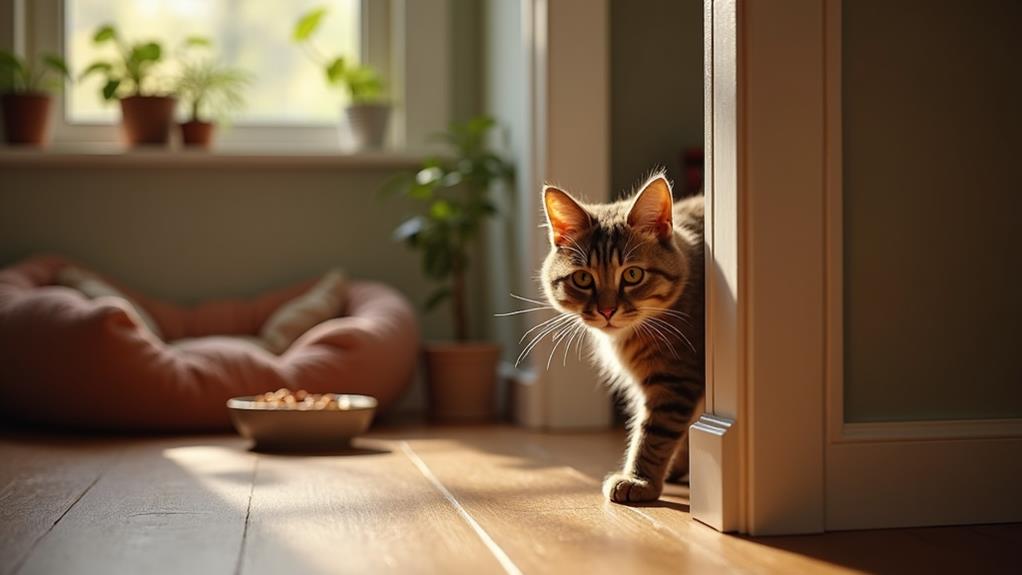
While enrichment activities improve a feral cat's indoor experience, addressing common challenges guarantees a smoother adjustment to their new environment. One frequent issue is scratching, a natural cat behavior. To mitigate scratching issues, provide several scratching posts around your home. This offers your cat designated areas for claw maintenance and territory marking, helping avoid damage to furniture.
Elimination problems can also arise during the changeover. These might stem from litter box preferences or their placement. Experiment with different litter types and guarantee the boxes are in quiet, accessible areas. By doing so, you'll increase the likelihood of your cat using the litter box consistently, preventing unwanted messes.
Understanding cat behavior is key to tackling indoor challenges effectively. Watch how your cat interacts with its surroundings to identify specific needs. To keep your cat stimulated and prevent boredom-related issues, engage in regular enrichment activities, like playtime and interactive toys. This not only improves their well-being but also aids in a successful changeover.
Here's how to address these challenges:
- Scratch Management: Offer multiple scratching surfaces.
- Litter Box Solutions: Try different litter types and placements.
- Behavior Observation: Tailor your approach based on behavior.
Celebrating Indoor Success Stories
Embracing the voyage of shifting a feral cat indoors can be incredibly rewarding. Many feral cats have made a successful conversion to become loving indoor cats, showcasing their adaptability and resilience. These success stories often emphasize the importance of providing the right environment and support. By allowing them to investigate their new indoor space gradually and at their own pace, you create a safe and secure atmosphere that fosters confidence.
One of the most rewarding aspects of this change is the positive impact on the cat's health. Indoor cats generally enjoy improved health and longer lifespans, often living twice as long as their outdoor counterparts. With the right care and environment, feral cats not only survive but thrive, revealing their potential for forming strong bonds with their human families.
To enhance their happiness and confidence, engage them in enrichment activities. Interactive toys and climbing structures are excellent ways to keep them entertained and content in their new surroundings. Shelters and organizations worldwide have demonstrated that with patience and consistent care, converting feral cats to indoor life is not just possible, but a quest filled with joyful, lasting connections.

